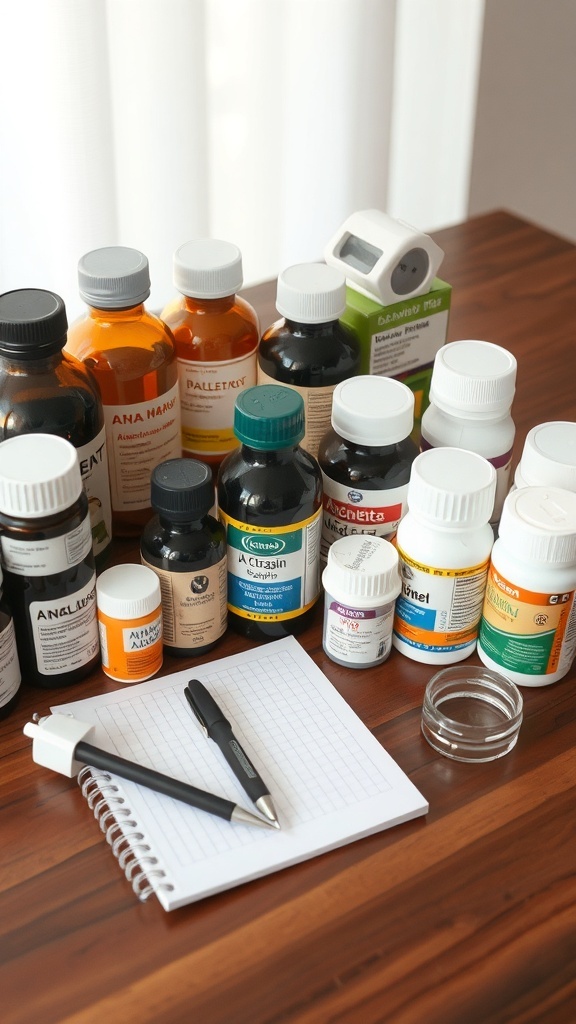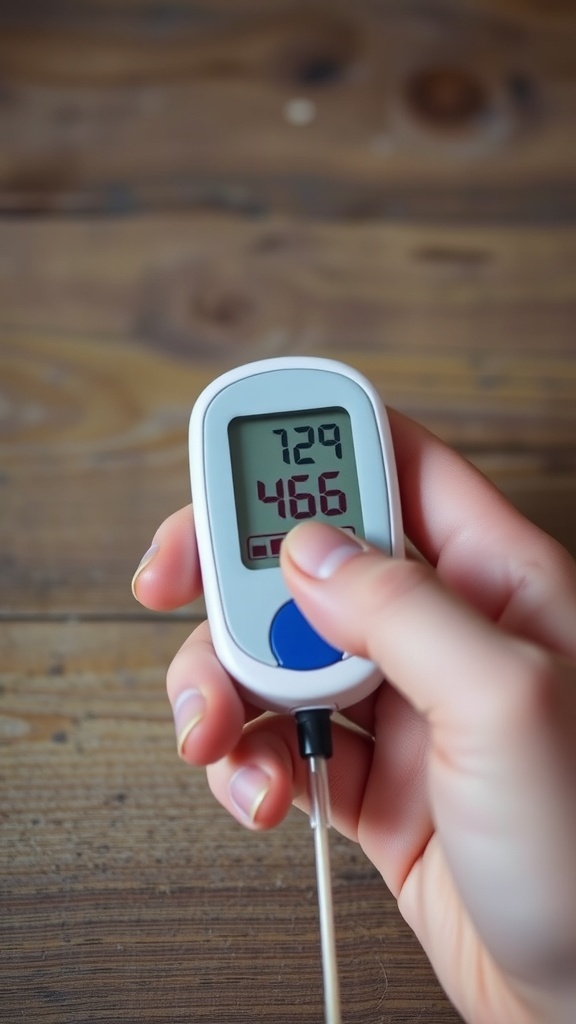Managing diabetes can feel overwhelming, especially after retirement when health becomes a top priority. This guide highlights ten essential diabetes basics that will equip retirees with the knowledge to effectively manage their health and enjoy this new chapter of life with confidence.
Understanding Diabetes Medications

Managing diabetes often means getting familiar with various medications. The image shows a collection of bottles, each representing different types of diabetes medications. These can range from pills to injectable treatments, all designed to help control blood sugar levels.
It’s important to understand that not all medications work the same for everyone. Some retirees might need oral medications, while others may require insulin. Keeping a list of your medications, like the notepad in the image, can help you track what you take and when.
Consulting with your healthcare provider is key. They can guide you on the best options based on your health needs. Remember, managing diabetes is a team effort, and your doctor is your partner in this journey.
Recognizing Symptoms of Hypoglycemia

Hypoglycemia, or low blood sugar, can sneak up on anyone, especially retirees managing diabetes. It’s crucial to recognize the signs early. The image shows an older gentleman sitting at a table, looking concerned while staring at a glass of orange juice. This scenario highlights a common response to feeling low: reaching for something sweet.
Symptoms of hypoglycemia can include sweating, shaking, confusion, and irritability. The man in the image seems to be in a moment of contemplation, perhaps feeling the effects of low blood sugar. It’s a reminder to stay alert to how we feel.
When you notice these signs, it’s important to act quickly. Consuming a quick source of sugar, like juice, can help raise blood sugar levels. The orange juice in the image symbolizes a simple and effective remedy. Keeping snacks handy can make a big difference in managing these episodes.
Understanding Blood Sugar Levels

Keeping track of blood sugar levels is key for managing diabetes. The image shows a blood glucose meter displaying two numbers: 729 and 466. These numbers indicate the blood sugar readings, which can vary throughout the day.
For many retirees, understanding these numbers is essential. A normal blood sugar level typically ranges from 70 to 130 mg/dL before meals and less than 180 mg/dL after meals. The readings in the image suggest that the blood sugar levels are quite high, which can be concerning.
Monitoring blood sugar helps in making informed decisions about diet, exercise, and medication. Regular checks can prevent complications and help maintain a healthy lifestyle. It’s a simple step that can lead to better health outcomes.
The Impact of Stress on Blood Sugar

Stress can really shake things up for those managing diabetes. When we feel stressed, our bodies release hormones like cortisol and adrenaline. These hormones can cause blood sugar levels to rise, making it harder to keep them in check.
The image shows a serene scene of an older man meditating outdoors. This peaceful moment highlights the importance of relaxation techniques in managing stress. Taking time to unwind can help lower those stress hormones and, in turn, stabilize blood sugar levels.
Finding ways to relax, whether through meditation, deep breathing, or gentle exercise, can be a game changer. It’s not just about managing diabetes; it’s about improving overall well-being. So, consider adding some calming practices to your daily routine.
Monitoring Blood Pressure and Cholesterol

Keeping track of blood pressure and cholesterol is key for retirees, especially those managing diabetes. Regular check-ups help catch any potential issues early. In the image, we see a doctor taking a patient’s blood pressure, a routine yet vital part of healthcare.
High blood pressure can lead to serious complications, including heart disease. It’s important to monitor it regularly. A simple cuff, like the one in the image, can provide quick readings. If numbers are consistently high, lifestyle changes or medication may be necessary.
Cholesterol levels also play a significant role in overall health. High levels can increase the risk of heart problems. A healthcare provider can recommend tests to check cholesterol levels and suggest dietary changes if needed. Eating heart-healthy foods can make a big difference.
Staying proactive about these health markers can lead to a healthier, more enjoyable retirement. Regular visits to the doctor, like the one shown in the image, are a great way to stay on top of your health.
The Role of Insulin in Diabetes Management

Insulin plays a key role in managing diabetes. It’s a hormone made by the pancreas that helps control blood sugar levels. When we eat, our bodies break down food into glucose, which is the main source of energy. Insulin helps move this glucose from the bloodstream into the cells, where it can be used for energy.
For those with diabetes, the body either doesn’t produce enough insulin or doesn’t use it effectively. This leads to high blood sugar levels, which can cause various health issues over time. Understanding how insulin works is essential for effective diabetes management.
Many people with diabetes need to monitor their insulin levels closely. This can involve taking insulin injections or using an insulin pump. Knowing when and how much insulin to take is crucial. It’s all about balancing food intake, activity levels, and insulin doses.
Regular check-ups with healthcare providers can help retirees stay on top of their insulin management. They can provide guidance on adjusting insulin doses based on lifestyle changes or health conditions. Staying informed and proactive can lead to better health outcomes.
Healthy Eating Habits for Diabetics

Eating well is key for managing diabetes, especially for retirees. The image shows a colorful bowl filled with fresh vegetables, nuts, and grains. This vibrant mix is a great example of what a healthy meal can look like.
Incorporating a variety of foods, like the peppers, onions, and greens in the bowl, can help keep meals interesting. These ingredients are low in carbohydrates and high in fiber, which is essential for blood sugar control.
Healthy eating for diabetics doesn’t mean giving up flavor. Using fresh herbs, like cilantro, adds zest without extra calories. The nuts and seeds provide healthy fats and protein, making meals satisfying.
When planning meals, aim for balance. Include lean proteins, healthy fats, and plenty of vegetables. This not only helps with blood sugar levels but also supports overall health.
Importance of Regular Physical Activity

Staying active is key for everyone, especially retirees managing diabetes. The image shows an older man jogging in a beautiful park. This scene highlights how enjoyable physical activity can be. A simple jog or walk can make a big difference in health.
Regular exercise helps control blood sugar levels. It also boosts mood and energy. For retirees, finding activities that are fun and engaging is important. Whether it’s walking, swimming, or dancing, the goal is to stay moving.
Being outdoors, like in the image, can enhance the experience. Nature provides a refreshing backdrop that can motivate you to keep going. Plus, socializing with others while being active can add to the enjoyment.
Incorporating physical activity into daily routines doesn’t have to be overwhelming. Start with small steps, like a short walk each day. Over time, these small changes can lead to significant health benefits.
Building a Support System for Diabetes Management

Managing diabetes can feel overwhelming, especially for retirees. Having a solid support system makes a big difference. The image shows a group of older women engaged in a discussion. This setting highlights the importance of community and sharing experiences.
Connecting with others who understand your journey can provide comfort and practical advice. Whether it’s family, friends, or support groups, having people around you can help you stay motivated and informed.
Consider joining a local diabetes support group. These gatherings offer a chance to learn from others, share tips, and even swap recipes. You can also find online communities that provide support and resources at your fingertips.
Remember, you’re not alone in this. Building a network of support can empower you to manage your diabetes effectively and live a fulfilling life.
Regular Health Check-ups and Screenings

Regular health check-ups are key for everyone, especially retirees managing diabetes. The image shows a doctor discussing important information with a patient in a bright, welcoming office. This setting emphasizes the importance of open communication during health visits.
Check-ups help monitor blood sugar levels and overall health. They allow doctors to catch any potential issues early. This proactive approach can make a big difference in managing diabetes effectively.
Screenings for blood pressure, cholesterol, and kidney function are also essential. These tests provide a clearer picture of your health and help tailor your treatment plan. Remember, staying informed is a big part of managing diabetes.
Don’t hesitate to ask your doctor questions during these visits. It’s your health, and understanding your condition is vital. Regular appointments can lead to better outcomes and a healthier lifestyle.